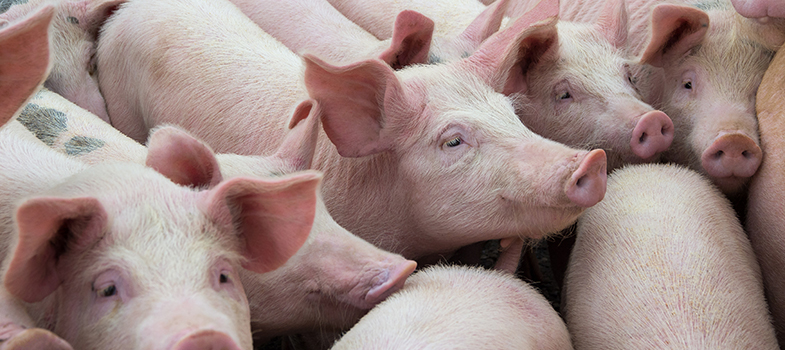Glossary
Special | A | B | C | D | E | F | G | H | I | J | K | L | M | N | O | P | Q | R | S | T | U | V | W | X | Y | Z | ALL
A |
|---|
active metabolitesA version of a drug that has been chemically changed by the body but still has antimicrobial properties. | |
antimicrobial residuesAntimicrobial drug molecules, or their metabolites, that remain in the meat of an animal after treatment, or are excreted into the environment by an animal or person, or enter the environment via water (e.g. via effluent and wastewater systems, or antibiotic treatment of aquatic species) or pharmaceutical waste. | |
antimicrobial resistance genes (ARGs)Genes that confer antibiotic resistance to bacteria. | |
antimicrobial susceptibility testing (AST)A microbiological test to determine whether bacteria are susceptible or resistant to an antibiotic. | |
antimicrobial use (AMU)The quantity of antimicrobial drugs prescribed or administered to an individual person or animal, or group of animals (e.g., herd, flock), measured at the level of healthcare facility, farm, region or country. It is typically measured as kg of antibiotics, and may also be referred to as ‘antimicrobial usage’. | |
B |
|---|
bioavailabilityThe proportion of a dose of an antimicrobial drug that reaches the blood after being given orally. | |
C |
|---|
commensalBacteria species that are part of the normal flora (microbiome) of a human or animal, and do not normally cause disease. | |
critically important antimicrobialsA WHO list of the most important antimicrobials in human medicine. The list is intended to assist in prudent use of antimicrobials in both humans and animals. | |
E |
|---|
extended spectrum beta-lactamase (ESBL)An enzyme that increases resistance to certain antibiotics. | |
extensive animal productionSystems that compared to intensive production use relatively larger amounts of land, as well as lower human inputs such as labour and processed feed. Examples include sheep farms where most of the nutrition is provided by grazing. | |
G |
|---|
genotypic methodsLaboratory techniques for investigating resistant bacteria based on the detection of genes. | |
growth promotionThe use of antibiotics at sub-therapeutic doses, usually in feed, to increase productivity. | |
H |
|---|
horizontal gene transferThe process of transferring genetic information between two unrelated cells. It is the primary mechanism of spreading antibiotic resistance, because it allows bacteria to spread antibiotic resistance genes rapidly between different species. | |
M |
|---|
metaphylactic useThe administration of therapeutic doses of antimicrobials to groups of animals in order to prevent the spread of clinical disease once some animals in the group show symptoms. It may also be referred to as ‘metaphylaxis’. | |
microbiomeThe collection of all the microbial genes in the microbiota. | |
microbiotaThe community of micro-organisms living together in a particular habitat. | |
molecular methodsLaboratory techniques for investigating resistant bacteria based on analysing molecules such as DNA, RNA and protein. | |
monitoringThe intermittent performance and analysis of routine measurements and observations, aimed at detecting changes in the environment or health status of a population. | |
O |
|---|
opportunistic pathogensBacteria that usually exists on or in a host species without causing it problems; however, they can invade the host and become pathogenic if the host’s natural defences are breached. | |
P |
|---|
pathogenicSomething that is capable of causing disease. | |
prevalenceThe proportion of a population that is suffering from a particular disease at a particular time: for example, the proportion of Salmonella isolates that are resistant to a particular antimicrobial at the time of testing. | |
prophylactic useMeasures designed to preserve health and prevent the spread of disease, protective or preventive treatment: for example, administering therapeutic doses of antimicrobials to groups of animals to prevent clinical disease. It may also be referred to as ‘prophylaxis’. | |
R |
|---|
reservoirAny component of a system that can contain resistant bacteria or antimicrobial resistance genes (ARGs). | |
residuesUnabsorbed drugs or their metabolic products that are excreted by animals treated with the drugs. | |
risk factorsFactors that influence the risk of causing adverse effects (such as contracting an AMR infection) in specific subpopulations. | |
S |
|---|
stakeholdersProfessionals, people or organisations involved in a system such as a food animal production system. | |
sub-therapeuticA dose of a drug that is insufficient for a clinical effect. Sub-therapeutic doses of antimicrobials kill susceptible bacteria, enabling the resistant bacteria to increase in the population. | |
surveillanceThe ongoing and systematic collection, analysis and interpretation of human and/or animal health-related data essential to planning, implementation and evaluation of public health practice. It includes dissemination of the information to those who need to know so that actions can be taken. | |
T |
|---|
therapeutic useThe use of antibiotics to treat animals showing signs of disease. | |
tilapiaThe common name for several species of fish (such as Oreochromis niloticus) that are used for food production in aquaculture systems. | |
V |
|---|
vertical gene transferThe process by which genes are transferred from parent to offspring. | |
W |
|---|
withdrawal periodThe minimum period required between the last administration of the antimicrobial and slaughter/harvest. It may also be referred to as a ‘withholding period’. | |
Z |
|---|
zoonotic bacteriaBacteria that can be transmitted directly or indirectly from animals to people and cause infection. | |
For further information, take a look at our frequently asked questions which may give you the support you need.
If you have any concerns about anything on this site please get in contact with us here.



